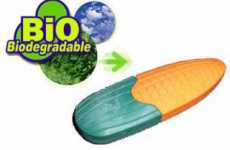



Things that break down and decompose to fight global warming
Implications - Reduce, reuse and recycle were the hip ecowords of the 90s, and it looks as if “biodegradable” and “compostable” could be their new millennial substitutes. Using eco-friendly merchandise that decomposes, from containers to beds, is the latest innovation soothing consumer consciences.
Trend Themes
1. Biodegradable & Compostable Products as Substitutes for Environmentally Unsustainable Ones - With many consumers looking to reduce their carbon footprint, businesses must consider more eco-friendly options when designing products. Incorporating green elements such as biodegradable material or recyclable elements are great ways for companies to contribute to the health of the planet while making a profit.
2. Edible and Compostable Food Packaging - Introducing compostable bee's wax to starchy peptides in materials like pea starch or 100% biodegradable cassava for use in food packaging can provide a sustainable solution to the problem of plastic waste.
3. Composting, Vermiculture, and High-rise Composting - Businesses may disrupt traditional household waste disposal by providing high-rise, vermiculture, or other innovative composting solutions to support the sustainable disposal of organic waste.
Industry Implications
1. Food Packaging - Food packaging industry professionals may look to adapt sustainable, compostable food packaging materials and innovative printing processes in eco-friendly packaging design.
2. Home and Composting Technology - Manufacturers of home technology can innovate ways to provide an eco-friendly option for homeowners looking to compost, such as vermicomposting solutions, high rise composters, and Bio Pod hygienic waste containers.
3. Fashion and Design - Fashion and design business professionals can look to follow in the footsteps of designers like Helen Storey and create biodegradable couture, furniture, and novel designs for commonly used items.
9 Featured
105,900 Total Clicks
Date Range:
Feb 08 — Sep 08
Trending:
Warm
Consumer Insight Topics:





